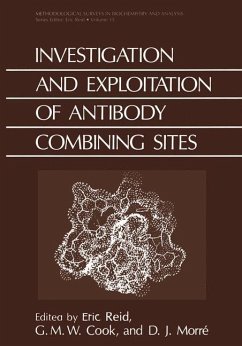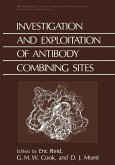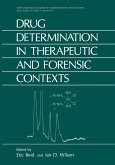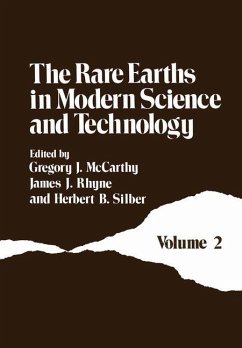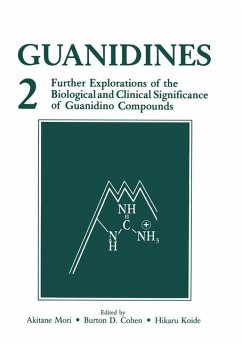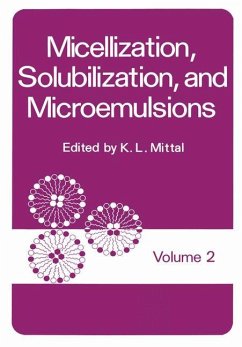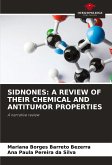- Broschiertes Buch
Andere Kunden interessierten sich auch für
![Investigation and Exploitation of Antibody Combining Sites Investigation and Exploitation of Antibody Combining Sites]() Eric ReidInvestigation and Exploitation of Antibody Combining Sites99,99 €
Eric ReidInvestigation and Exploitation of Antibody Combining Sites99,99 €![Drug Determination in Therapeutic and Forensic Contexts Drug Determination in Therapeutic and Forensic Contexts]() Eric ReidDrug Determination in Therapeutic and Forensic Contexts77,99 €
Eric ReidDrug Determination in Therapeutic and Forensic Contexts77,99 €![The Rare Earths in Modern Science and Technology The Rare Earths in Modern Science and Technology]() G. J. McCarthyThe Rare Earths in Modern Science and Technology39,99 €
G. J. McCarthyThe Rare Earths in Modern Science and Technology39,99 €![Guanidines 2 Guanidines 2]() Akitane MoriGuanidines 238,99 €
Akitane MoriGuanidines 238,99 €![Micellization, Solubilization, and Microemulsions Micellization, Solubilization, and Microemulsions]() Kashmiri L. MittalMicellization, Solubilization, and Microemulsions39,99 €
Kashmiri L. MittalMicellization, Solubilization, and Microemulsions39,99 €![SIDNONES: A REVIEW OF THEIR CHEMICAL AND ANTITUMOR PROPERTIES SIDNONES: A REVIEW OF THEIR CHEMICAL AND ANTITUMOR PROPERTIES]() Mariana Borges Barreto BezerraSIDNONES: A REVIEW OF THEIR CHEMICAL AND ANTITUMOR PROPERTIES29,99 €
Mariana Borges Barreto BezerraSIDNONES: A REVIEW OF THEIR CHEMICAL AND ANTITUMOR PROPERTIES29,99 €![Marketing Fresh Fruits and Vegetables Marketing Fresh Fruits and Vegetables]() Richard B. HowMarketing Fresh Fruits and Vegetables38,99 €
Richard B. HowMarketing Fresh Fruits and Vegetables38,99 €-
-
-
Produktdetails
- Methodological Surveys in Biochemistry and Analysis .15B
- Verlag: Springer / Springer US / Springer, Berlin
- Artikelnr. des Verlages: 978-1-4684-5008-8
- Softcover reprint of the original 1st ed. 1985
- Seitenzahl: 384
- Erscheinungstermin: 25. November 2012
- Englisch
- Abmessung: 244mm x 170mm x 21mm
- Gewicht: 661g
- ISBN-13: 9781468450088
- ISBN-10: 1468450085
- Artikelnr.: 37479593
Hinweis: Dieser Artikel kann nur an eine deutsche Lieferadresse ausgeliefert werden.
- Herstellerkennzeichnung Die Herstellerinformationen sind derzeit nicht verfügbar.
#A Antibody Combining Sites, Especially Structure.- #A-1 Antibody combining sites - past, present and future.- #A-2 Variability, modelling and prediction of ?-hairpins with reference to the immunoglobulin fold.- #A-3 Probing the binding sites in crystals of immunoglobulins.- #A-4 Comparative structures of mouse antibody combining sites.- #NC(A) NOTE and COMMENTS related to the foregoing topics*.- #NC(A)-1 An approach to the study of anti-protein antibody combining sites.- #B Production and Characterization of Antibodies, in Contexts such as Receptor Investigation.- #B-1 Investigating the specificity of monoclonal antibodies to protein antigens using ?-galactosidase fusion proteins.- #B-2 Antibody-screening cDNA libraries.- #B-3 Anti-receptor antibodies by the auto-anti-idiotypic route.- #B-4 Production and characterization of anti-morphine anti-idiotypic antibodies.- #B-5 Anti-idiotype antibodies for the study of membrane receptors: the double monoclonal antibody approach.- #NC(B) NOTES and COMMENTS related to the foregoing topics.- #NC(B)-1 Characterization of idiotypes and VH genes of various members of A48-idiotypic network pathway.- #NC(B)-2 Monoclonal internal image anti-idiotypic antibodies of hepatitis B surface antigen.- #NC(B)-3 Structure and expression of genes encoding IgA heavy chains.- #NC(B)-4 Human:mouse antibody-producing transfectoma cell lines.- #NC(B)-5 Different ways to modify monoclonal antibodies.- #NC(B)-6 Restructuring enzymes and antibodies.- #NC(B)-7 Dideoxy mRNA sequencing as a method to analyze antibody diversity.- #NC(B)-8 Effect of multivalent binding on dissociation of monoclonal antibodies from cell surface antigens.- #C Cytoskeletal, Myocyte and Neuronal Studies with Antibodies.- #C-1Immunological approaches and techniques employed in tubulin and microtubule research.- #C-2 Cell-surface events during myogenesis: immunofluorescence analysis using monoclonal antibodies.- #C-3 Differential expression of cell-surface antigens on muscle satellite cells and myoblasts.- #C-4 Cholinergic-specific nerve terminal antigens.- #C-5 Use of antibodies to purify cholinergic nerve terminals.- #NC(C) NOTES and COMMENTS related to the foregoing topics.- #NC(C)-1 An immunological approach to the cell lineage problem in the mammalian CNS.- #NC(C)-2 An enzyme-linked immunosorbent assay for calmodulin.- #NC(C)-3 Intermediate filament diversity as detected by antibodies.- #D Antibody Approaches to Membrane Components Including the T-Cell Receptor.- #D-1 Exploitation of antibodies in the study of cell membranes.- #D-2 Use of polyclonal and monoclonal antibodies in studying complement component C9 as a transmembrane protein.- #D-3 Ca2+-binding proteins located on the cytoplasmic face of the lymphocyte plasma membrane.- #D-4 The T-cell receptor.- #NC(D) NOTES and COMMENTS related to the foregoing topics.- #NC(D)-1 New light on the T-cell receptor in relation to antibody binding sites.- #NC(D)-2 Molecular nature of the T3 antigen of human T lymphocytes.- #NC(D)-3 Organization and expression of the murine T-cell receptor ?-chain gene complex.- #NC(D)-4 Antigen-specific T-cell activation.- #E Antibodies in Relation to Oncology.- #E-1 Requirements by cancer cells for polypeptide growth factors suggest new therapeutic strategies.- #E-2 Monoclonal antibodies to human tumours for targeting cytotoxic drugs.- #E-3 Antigenic modulation as a limiting factor in the treatment of B-cell lymphoma with anti-idiotype antibody.- #E-4 Tumour-associatedcarbohydrate antigens of glycoproteins.- #E-5 Glycolipid antigens: potential in cancer detection and diagnosis.- #NC(E) NOTES and COMMENTS related to the foregoing topics.- #NC(E)-1 Immune surveillance.- #NC(E)-2 WORKSHOP DISCUSSION focused on #E-4, #E-5 & #E-3.- Guidance for 'uninitiated' readers.- Corrections to Vol. 13.
#A Antibody Combining Sites, Especially Structure.
#A
1 Antibody combining sites
past, present and future.
#A
2 Variability, modelling and prediction of ?
hairpins with reference to the immunoglobulin fold.
#A
3 Probing the binding sites in crystals of immunoglobulins.
#A
4 Comparative structures of mouse antibody combining sites.
#NC(A) NOTE and COMMENTS related to the foregoing topics*.
#NC(A)
1 An approach to the study of anti
protein antibody combining sites.
#B Production and Characterization of Antibodies, in Contexts such as Receptor Investigation.
#B
1 Investigating the specificity of monoclonal antibodies to protein antigens using ?
galactosidase fusion proteins.
#B
2 Antibody
screening cDNA libraries.
#B
3 Anti
receptor antibodies by the auto
anti
idiotypic route.
#B
4 Production and characterization of anti
morphine anti
idiotypic antibodies.
#B
5 Anti
idiotype antibodies for the study of membrane receptors: the double monoclonal antibody approach.
#NC(B) NOTES and COMMENTS related to the foregoing topics.
#NC(B)
1 Characterization of idiotypes and VH genes of various members of A48
idiotypic network pathway.
#NC(B)
2 Monoclonal internal image anti
idiotypic antibodies of hepatitis B surface antigen.
#NC(B)
3 Structure and expression of genes encoding IgA heavy chains.
#NC(B)
4 Human:mouse antibody
producing transfectoma cell lines.
#NC(B)
5 Different ways to modify monoclonal antibodies.
#NC(B)
6 Restructuring enzymes and antibodies.
#NC(B)
7 Dideoxy mRNA sequencing as a method to analyze antibody diversity.
#NC(B)
8 Effect of multivalent binding on dissociation of monoclonal antibodies from cell surface antigens.
#C Cytoskeletal, Myocyte and Neuronal Studies with Antibodies.
#C
1Immunological approaches and techniques employed in tubulin and microtubule research.
#C
2 Cell
surface events during myogenesis: immunofluorescence analysis using monoclonal antibodies.
#C
3 Differential expression of cell
surface antigens on muscle satellite cells and myoblasts.
#C
4 Cholinergic
specific nerve terminal antigens.
#C
5 Use of antibodies to purify cholinergic nerve terminals.
#NC(C) NOTES and COMMENTS related to the foregoing topics.
#NC(C)
1 An immunological approach to the cell lineage problem in the mammalian CNS.
#NC(C)
2 An enzyme
linked immunosorbent assay for calmodulin.
#NC(C)
3 Intermediate filament diversity as detected by antibodies.
#D Antibody Approaches to Membrane Components Including the T
Cell Receptor.
#D
1 Exploitation of antibodies in the study of cell membranes.
#D
2 Use of polyclonal and monoclonal antibodies in studying complement component C9 as a transmembrane protein.
#D
3 Ca2+
binding proteins located on the cytoplasmic face of the lymphocyte plasma membrane.
#D
4 The T
cell receptor.
#NC(D) NOTES and COMMENTS related to the foregoing topics.
#NC(D)
1 New light on the T
cell receptor in relation to antibody binding sites.
#NC(D)
2 Molecular nature of the T3 antigen of human T lymphocytes.
#NC(D)
3 Organization and expression of the murine T
cell receptor ?
chain gene complex.
#NC(D)
4 Antigen
specific T
cell activation.
#E Antibodies in Relation to Oncology.
#E
1 Requirements by cancer cells for polypeptide growth factors suggest new therapeutic strategies.
#E
2 Monoclonal antibodies to human tumours for targeting cytotoxic drugs.
#E
3 Antigenic modulation as a limiting factor in the treatment of B
cell lymphoma with anti
idiotype antibody.
#E
4 Tumour
associatedcarbohydrate antigens of glycoproteins.
#E
5 Glycolipid antigens: potential in cancer detection and diagnosis.
#NC(E) NOTES and COMMENTS related to the foregoing topics.
#NC(E)
1 Immune surveillance.
#NC(E)
2 WORKSHOP DISCUSSION focused on #E
4, #E
5 & #E
3.
Guidance for 'uninitiated' readers.
Corrections to Vol. 13.
#A
1 Antibody combining sites
past, present and future.
#A
2 Variability, modelling and prediction of ?
hairpins with reference to the immunoglobulin fold.
#A
3 Probing the binding sites in crystals of immunoglobulins.
#A
4 Comparative structures of mouse antibody combining sites.
#NC(A) NOTE and COMMENTS related to the foregoing topics*.
#NC(A)
1 An approach to the study of anti
protein antibody combining sites.
#B Production and Characterization of Antibodies, in Contexts such as Receptor Investigation.
#B
1 Investigating the specificity of monoclonal antibodies to protein antigens using ?
galactosidase fusion proteins.
#B
2 Antibody
screening cDNA libraries.
#B
3 Anti
receptor antibodies by the auto
anti
idiotypic route.
#B
4 Production and characterization of anti
morphine anti
idiotypic antibodies.
#B
5 Anti
idiotype antibodies for the study of membrane receptors: the double monoclonal antibody approach.
#NC(B) NOTES and COMMENTS related to the foregoing topics.
#NC(B)
1 Characterization of idiotypes and VH genes of various members of A48
idiotypic network pathway.
#NC(B)
2 Monoclonal internal image anti
idiotypic antibodies of hepatitis B surface antigen.
#NC(B)
3 Structure and expression of genes encoding IgA heavy chains.
#NC(B)
4 Human:mouse antibody
producing transfectoma cell lines.
#NC(B)
5 Different ways to modify monoclonal antibodies.
#NC(B)
6 Restructuring enzymes and antibodies.
#NC(B)
7 Dideoxy mRNA sequencing as a method to analyze antibody diversity.
#NC(B)
8 Effect of multivalent binding on dissociation of monoclonal antibodies from cell surface antigens.
#C Cytoskeletal, Myocyte and Neuronal Studies with Antibodies.
#C
1Immunological approaches and techniques employed in tubulin and microtubule research.
#C
2 Cell
surface events during myogenesis: immunofluorescence analysis using monoclonal antibodies.
#C
3 Differential expression of cell
surface antigens on muscle satellite cells and myoblasts.
#C
4 Cholinergic
specific nerve terminal antigens.
#C
5 Use of antibodies to purify cholinergic nerve terminals.
#NC(C) NOTES and COMMENTS related to the foregoing topics.
#NC(C)
1 An immunological approach to the cell lineage problem in the mammalian CNS.
#NC(C)
2 An enzyme
linked immunosorbent assay for calmodulin.
#NC(C)
3 Intermediate filament diversity as detected by antibodies.
#D Antibody Approaches to Membrane Components Including the T
Cell Receptor.
#D
1 Exploitation of antibodies in the study of cell membranes.
#D
2 Use of polyclonal and monoclonal antibodies in studying complement component C9 as a transmembrane protein.
#D
3 Ca2+
binding proteins located on the cytoplasmic face of the lymphocyte plasma membrane.
#D
4 The T
cell receptor.
#NC(D) NOTES and COMMENTS related to the foregoing topics.
#NC(D)
1 New light on the T
cell receptor in relation to antibody binding sites.
#NC(D)
2 Molecular nature of the T3 antigen of human T lymphocytes.
#NC(D)
3 Organization and expression of the murine T
cell receptor ?
chain gene complex.
#NC(D)
4 Antigen
specific T
cell activation.
#E Antibodies in Relation to Oncology.
#E
1 Requirements by cancer cells for polypeptide growth factors suggest new therapeutic strategies.
#E
2 Monoclonal antibodies to human tumours for targeting cytotoxic drugs.
#E
3 Antigenic modulation as a limiting factor in the treatment of B
cell lymphoma with anti
idiotype antibody.
#E
4 Tumour
associatedcarbohydrate antigens of glycoproteins.
#E
5 Glycolipid antigens: potential in cancer detection and diagnosis.
#NC(E) NOTES and COMMENTS related to the foregoing topics.
#NC(E)
1 Immune surveillance.
#NC(E)
2 WORKSHOP DISCUSSION focused on #E
4, #E
5 & #E
3.
Guidance for 'uninitiated' readers.
Corrections to Vol. 13.
#A Antibody Combining Sites, Especially Structure.- #A-1 Antibody combining sites - past, present and future.- #A-2 Variability, modelling and prediction of ?-hairpins with reference to the immunoglobulin fold.- #A-3 Probing the binding sites in crystals of immunoglobulins.- #A-4 Comparative structures of mouse antibody combining sites.- #NC(A) NOTE and COMMENTS related to the foregoing topics*.- #NC(A)-1 An approach to the study of anti-protein antibody combining sites.- #B Production and Characterization of Antibodies, in Contexts such as Receptor Investigation.- #B-1 Investigating the specificity of monoclonal antibodies to protein antigens using ?-galactosidase fusion proteins.- #B-2 Antibody-screening cDNA libraries.- #B-3 Anti-receptor antibodies by the auto-anti-idiotypic route.- #B-4 Production and characterization of anti-morphine anti-idiotypic antibodies.- #B-5 Anti-idiotype antibodies for the study of membrane receptors: the double monoclonal antibody approach.- #NC(B) NOTES and COMMENTS related to the foregoing topics.- #NC(B)-1 Characterization of idiotypes and VH genes of various members of A48-idiotypic network pathway.- #NC(B)-2 Monoclonal internal image anti-idiotypic antibodies of hepatitis B surface antigen.- #NC(B)-3 Structure and expression of genes encoding IgA heavy chains.- #NC(B)-4 Human:mouse antibody-producing transfectoma cell lines.- #NC(B)-5 Different ways to modify monoclonal antibodies.- #NC(B)-6 Restructuring enzymes and antibodies.- #NC(B)-7 Dideoxy mRNA sequencing as a method to analyze antibody diversity.- #NC(B)-8 Effect of multivalent binding on dissociation of monoclonal antibodies from cell surface antigens.- #C Cytoskeletal, Myocyte and Neuronal Studies with Antibodies.- #C-1Immunological approaches and techniques employed in tubulin and microtubule research.- #C-2 Cell-surface events during myogenesis: immunofluorescence analysis using monoclonal antibodies.- #C-3 Differential expression of cell-surface antigens on muscle satellite cells and myoblasts.- #C-4 Cholinergic-specific nerve terminal antigens.- #C-5 Use of antibodies to purify cholinergic nerve terminals.- #NC(C) NOTES and COMMENTS related to the foregoing topics.- #NC(C)-1 An immunological approach to the cell lineage problem in the mammalian CNS.- #NC(C)-2 An enzyme-linked immunosorbent assay for calmodulin.- #NC(C)-3 Intermediate filament diversity as detected by antibodies.- #D Antibody Approaches to Membrane Components Including the T-Cell Receptor.- #D-1 Exploitation of antibodies in the study of cell membranes.- #D-2 Use of polyclonal and monoclonal antibodies in studying complement component C9 as a transmembrane protein.- #D-3 Ca2+-binding proteins located on the cytoplasmic face of the lymphocyte plasma membrane.- #D-4 The T-cell receptor.- #NC(D) NOTES and COMMENTS related to the foregoing topics.- #NC(D)-1 New light on the T-cell receptor in relation to antibody binding sites.- #NC(D)-2 Molecular nature of the T3 antigen of human T lymphocytes.- #NC(D)-3 Organization and expression of the murine T-cell receptor ?-chain gene complex.- #NC(D)-4 Antigen-specific T-cell activation.- #E Antibodies in Relation to Oncology.- #E-1 Requirements by cancer cells for polypeptide growth factors suggest new therapeutic strategies.- #E-2 Monoclonal antibodies to human tumours for targeting cytotoxic drugs.- #E-3 Antigenic modulation as a limiting factor in the treatment of B-cell lymphoma with anti-idiotype antibody.- #E-4 Tumour-associatedcarbohydrate antigens of glycoproteins.- #E-5 Glycolipid antigens: potential in cancer detection and diagnosis.- #NC(E) NOTES and COMMENTS related to the foregoing topics.- #NC(E)-1 Immune surveillance.- #NC(E)-2 WORKSHOP DISCUSSION focused on #E-4, #E-5 & #E-3.- Guidance for 'uninitiated' readers.- Corrections to Vol. 13.
#A Antibody Combining Sites, Especially Structure.
#A
1 Antibody combining sites
past, present and future.
#A
2 Variability, modelling and prediction of ?
hairpins with reference to the immunoglobulin fold.
#A
3 Probing the binding sites in crystals of immunoglobulins.
#A
4 Comparative structures of mouse antibody combining sites.
#NC(A) NOTE and COMMENTS related to the foregoing topics*.
#NC(A)
1 An approach to the study of anti
protein antibody combining sites.
#B Production and Characterization of Antibodies, in Contexts such as Receptor Investigation.
#B
1 Investigating the specificity of monoclonal antibodies to protein antigens using ?
galactosidase fusion proteins.
#B
2 Antibody
screening cDNA libraries.
#B
3 Anti
receptor antibodies by the auto
anti
idiotypic route.
#B
4 Production and characterization of anti
morphine anti
idiotypic antibodies.
#B
5 Anti
idiotype antibodies for the study of membrane receptors: the double monoclonal antibody approach.
#NC(B) NOTES and COMMENTS related to the foregoing topics.
#NC(B)
1 Characterization of idiotypes and VH genes of various members of A48
idiotypic network pathway.
#NC(B)
2 Monoclonal internal image anti
idiotypic antibodies of hepatitis B surface antigen.
#NC(B)
3 Structure and expression of genes encoding IgA heavy chains.
#NC(B)
4 Human:mouse antibody
producing transfectoma cell lines.
#NC(B)
5 Different ways to modify monoclonal antibodies.
#NC(B)
6 Restructuring enzymes and antibodies.
#NC(B)
7 Dideoxy mRNA sequencing as a method to analyze antibody diversity.
#NC(B)
8 Effect of multivalent binding on dissociation of monoclonal antibodies from cell surface antigens.
#C Cytoskeletal, Myocyte and Neuronal Studies with Antibodies.
#C
1Immunological approaches and techniques employed in tubulin and microtubule research.
#C
2 Cell
surface events during myogenesis: immunofluorescence analysis using monoclonal antibodies.
#C
3 Differential expression of cell
surface antigens on muscle satellite cells and myoblasts.
#C
4 Cholinergic
specific nerve terminal antigens.
#C
5 Use of antibodies to purify cholinergic nerve terminals.
#NC(C) NOTES and COMMENTS related to the foregoing topics.
#NC(C)
1 An immunological approach to the cell lineage problem in the mammalian CNS.
#NC(C)
2 An enzyme
linked immunosorbent assay for calmodulin.
#NC(C)
3 Intermediate filament diversity as detected by antibodies.
#D Antibody Approaches to Membrane Components Including the T
Cell Receptor.
#D
1 Exploitation of antibodies in the study of cell membranes.
#D
2 Use of polyclonal and monoclonal antibodies in studying complement component C9 as a transmembrane protein.
#D
3 Ca2+
binding proteins located on the cytoplasmic face of the lymphocyte plasma membrane.
#D
4 The T
cell receptor.
#NC(D) NOTES and COMMENTS related to the foregoing topics.
#NC(D)
1 New light on the T
cell receptor in relation to antibody binding sites.
#NC(D)
2 Molecular nature of the T3 antigen of human T lymphocytes.
#NC(D)
3 Organization and expression of the murine T
cell receptor ?
chain gene complex.
#NC(D)
4 Antigen
specific T
cell activation.
#E Antibodies in Relation to Oncology.
#E
1 Requirements by cancer cells for polypeptide growth factors suggest new therapeutic strategies.
#E
2 Monoclonal antibodies to human tumours for targeting cytotoxic drugs.
#E
3 Antigenic modulation as a limiting factor in the treatment of B
cell lymphoma with anti
idiotype antibody.
#E
4 Tumour
associatedcarbohydrate antigens of glycoproteins.
#E
5 Glycolipid antigens: potential in cancer detection and diagnosis.
#NC(E) NOTES and COMMENTS related to the foregoing topics.
#NC(E)
1 Immune surveillance.
#NC(E)
2 WORKSHOP DISCUSSION focused on #E
4, #E
5 & #E
3.
Guidance for 'uninitiated' readers.
Corrections to Vol. 13.
#A
1 Antibody combining sites
past, present and future.
#A
2 Variability, modelling and prediction of ?
hairpins with reference to the immunoglobulin fold.
#A
3 Probing the binding sites in crystals of immunoglobulins.
#A
4 Comparative structures of mouse antibody combining sites.
#NC(A) NOTE and COMMENTS related to the foregoing topics*.
#NC(A)
1 An approach to the study of anti
protein antibody combining sites.
#B Production and Characterization of Antibodies, in Contexts such as Receptor Investigation.
#B
1 Investigating the specificity of monoclonal antibodies to protein antigens using ?
galactosidase fusion proteins.
#B
2 Antibody
screening cDNA libraries.
#B
3 Anti
receptor antibodies by the auto
anti
idiotypic route.
#B
4 Production and characterization of anti
morphine anti
idiotypic antibodies.
#B
5 Anti
idiotype antibodies for the study of membrane receptors: the double monoclonal antibody approach.
#NC(B) NOTES and COMMENTS related to the foregoing topics.
#NC(B)
1 Characterization of idiotypes and VH genes of various members of A48
idiotypic network pathway.
#NC(B)
2 Monoclonal internal image anti
idiotypic antibodies of hepatitis B surface antigen.
#NC(B)
3 Structure and expression of genes encoding IgA heavy chains.
#NC(B)
4 Human:mouse antibody
producing transfectoma cell lines.
#NC(B)
5 Different ways to modify monoclonal antibodies.
#NC(B)
6 Restructuring enzymes and antibodies.
#NC(B)
7 Dideoxy mRNA sequencing as a method to analyze antibody diversity.
#NC(B)
8 Effect of multivalent binding on dissociation of monoclonal antibodies from cell surface antigens.
#C Cytoskeletal, Myocyte and Neuronal Studies with Antibodies.
#C
1Immunological approaches and techniques employed in tubulin and microtubule research.
#C
2 Cell
surface events during myogenesis: immunofluorescence analysis using monoclonal antibodies.
#C
3 Differential expression of cell
surface antigens on muscle satellite cells and myoblasts.
#C
4 Cholinergic
specific nerve terminal antigens.
#C
5 Use of antibodies to purify cholinergic nerve terminals.
#NC(C) NOTES and COMMENTS related to the foregoing topics.
#NC(C)
1 An immunological approach to the cell lineage problem in the mammalian CNS.
#NC(C)
2 An enzyme
linked immunosorbent assay for calmodulin.
#NC(C)
3 Intermediate filament diversity as detected by antibodies.
#D Antibody Approaches to Membrane Components Including the T
Cell Receptor.
#D
1 Exploitation of antibodies in the study of cell membranes.
#D
2 Use of polyclonal and monoclonal antibodies in studying complement component C9 as a transmembrane protein.
#D
3 Ca2+
binding proteins located on the cytoplasmic face of the lymphocyte plasma membrane.
#D
4 The T
cell receptor.
#NC(D) NOTES and COMMENTS related to the foregoing topics.
#NC(D)
1 New light on the T
cell receptor in relation to antibody binding sites.
#NC(D)
2 Molecular nature of the T3 antigen of human T lymphocytes.
#NC(D)
3 Organization and expression of the murine T
cell receptor ?
chain gene complex.
#NC(D)
4 Antigen
specific T
cell activation.
#E Antibodies in Relation to Oncology.
#E
1 Requirements by cancer cells for polypeptide growth factors suggest new therapeutic strategies.
#E
2 Monoclonal antibodies to human tumours for targeting cytotoxic drugs.
#E
3 Antigenic modulation as a limiting factor in the treatment of B
cell lymphoma with anti
idiotype antibody.
#E
4 Tumour
associatedcarbohydrate antigens of glycoproteins.
#E
5 Glycolipid antigens: potential in cancer detection and diagnosis.
#NC(E) NOTES and COMMENTS related to the foregoing topics.
#NC(E)
1 Immune surveillance.
#NC(E)
2 WORKSHOP DISCUSSION focused on #E
4, #E
5 & #E
3.
Guidance for 'uninitiated' readers.
Corrections to Vol. 13.

